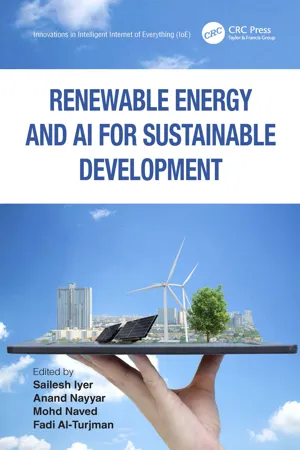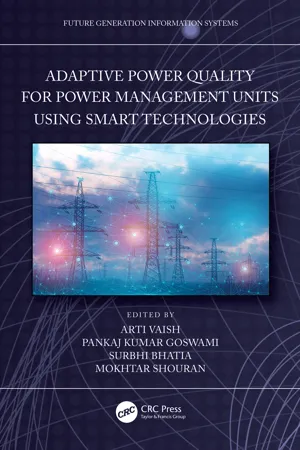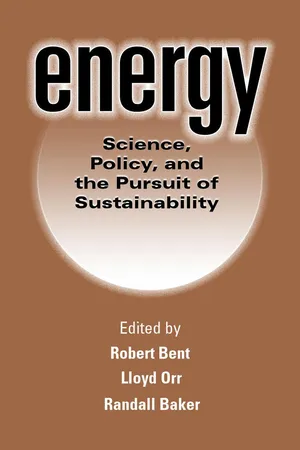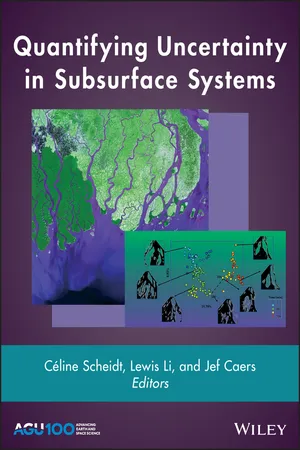Geography
Future Energy Resources
Future energy resources refer to the potential sources of energy that could be harnessed in the coming years to meet the world's growing energy needs. These resources include renewable sources such as solar, wind, and hydroelectric power, as well as emerging technologies like tidal and geothermal energy. The exploration and development of future energy resources are crucial for transitioning towards a more sustainable and environmentally friendly energy landscape.
Written by Perlego with AI-assistance
Related key terms
6 Key excerpts on "Future Energy Resources"
- Sailesh Iyer, Anand Nayyar, Mohd Naved, Fadi Al-Turjman, Sailesh Iyer, Anand Nayyar, Mohd Naved, Fadi Al-Turjman(Authors)
- 2023(Publication Date)
- CRC Press(Publisher)
2 An Overview of Global Renewable Energy ResourcesPresent Scenario, Policies, and Future ProspectsV. Manimegalai1 , V. Rukkumani2 , A. Gayathri1 , P. Pandiyan3 and V. Mohanapriya41 Department of EEE, Sri Krishna College of Technology, Coimbatore, Tamil Nadu, India2 Department of EIE, Sri Ramakrishna Engineering College, Coimbatore, Tamil Nadu, India3 Department of EEE, KPR Institute of Engineering and Technology, Coimbatore, Tamil Nadu, India4 Department of EEE, Bannari Amman Institute of Technology, Erode, Tamil Nadu, IndiaDOI: 10.1201/9781003369554-2CONTENTS
- 2.1 Introduction
- 2.2 Classification of Renewable Energy Sources
- 2.2.1 Biomass
- 2.2.2 Geothermal Energy
- 2.2.3 Hydro Energy
- 2.2.4 Solar Energy
- 2.2.4.1 Photovoltaic
- 2.2.4.2 Concentrating Solar Power
- 2.2.4.3 Solar Thermal Heating and Cooling
- 2.2.5 Wind Energy
- 2.2.6 Marine Energy
- 2.3 Renewable Energy and Sustainable Development
- 2.4 Renewable Energy and Climate Change
- 2.5 Policies and Incentives
- 2.6 Challenges Affecting Renewable Energy Sources
- 2.7 Benefits of Renewable Energy Sources
- 2.8 Conclusion and Future Scope
- References
2.1 Introduction
Human evolution has been based on the availability and use of energy. From the use of fire and animal power in the early days to the increasingly widespread use of electricity and cleaner sustainable fuels for various purposes, energy has been a fundamental driving force for human progress. In every country, the need for energy can be seen in a variety of sectors, including the provision of key services such as lighting, cooking, cooling, mobility, heating, and the functioning of machines and telecommunications equipment. Today, the inadequacy of reliable and clean energy supplies is regarded as one of the most considerable barriers to improving human wellbeing worldwide. Fossil fuels are expected to be exhausted due to the substantial growth of the population that has caused a significant change in the global energy demand. Numerous renewable energy resources have been used to combat this concern, such as wind, biomass, solar, geothermal, and tidal.- Arti Vaish, Pankaj Kumar Goswami, Surbhi Bhatia, Mokhtar Shouran, Arti Vaish, Pankaj Kumar Goswami, Surbhi Bhatia, Mokhtar Shouran(Authors)
- 2023(Publication Date)
- CRC Press(Publisher)
The building of the most reliable grid can be sustained by geothermal energy since it is more consistent in supply than other RES. Conclusively, energy from geothermal plants occupies a critical gap in achieving the goal of green energy transition and green global communities. 3.4 The indispensability of fossil fuels The discovery and utilization of fossil fuels such as coal, gas, and oil have indeed revolutionized the world in all facets of life, be it the power sector, transportation systems, or economic systems. It is one of the key drivers that catalyzed the first Industrial Revolution and hence a factor that also contributed immensely to global technological advancement. It is imperative to know that about 80% of the world’s energy is supplied by the combustion of fossil fuels [ 138 ]. Despite the claim that the continued utilization of fossil fuel-based resources is contributing to global climate change, it is increasingly difficult to abruptly jettison it when looking at the constraints surrounding the development and utilization of RES. These constraints include intermittency for solar, location dependency in terms of a viable wind speed regime for wind energy, and technological know-how for the integration of geothermal energy and biogas. In addition to the above limitations regarding the massive deployment of RES, fossil fuels are extremely excellent fuels with greater efficiency, as a little quantity of them carries sufficient energy density. Also, unlike most RES that are weather dependent, fossil fuel can be conveniently used anywhere, anytime, in the world where the requisite infrastructure exists- eBook - ePub
Energy and Society
A Critical Perspective
- Gavin Bridge, Stewart Barr, Stefan Bouzarovski, Michael Bradshaw, Ed Brown, Harriet Bulkeley, Gordon Walker(Authors)
- 2018(Publication Date)
- Routledge(Publisher)
Figure 1.2 ), deploying it to transform the environment and accumulate economic and social infrastructure. The amount of energy under human control has increased enormously: Grubler (2004) estimates that global energy use in 1800 stood at around 20 exajoules, increased to 50 exajoules by 1900 and by 2010 was around 500 exajoules. In short, global energy use has risen twentyfold in 200 years, while the population has increased sevenfold (Smil 2010). The result is that energy has become much more abundant over time, as measured by both the quantity available per capita and the time/energy that must be expended to acquire it. Large portions of the population have become accustomed to living in a high-energy society, while this is also an aspiration for most people who do not yet have it. However, the small fraction of the Earth’s energy resources that can be captured, harnessed and transformed is unevenly distributed in fundamental ways. High-quality energy resources do not occur everywhere and access to resources and key technologies of energy capture and transformation is structured by prevailing distributions of wealth and power. Similarly, the social and environmental acceptability of energy resource landscapes also demonstrates social and spatial variation, as does the environmental and social consequences of energy production and transportation.Figure 1.2 Energy availability over time (based on GEA 2013)The search for socially valuable energy resources has diversified humanity’s portfolio of primary and secondary energy sources over time (Figure 1.2 ). Simultaneously, however, a small group of primary and secondary sources have become dominant in the global energy mix. First, three hydrocarbon energy resources – oil, coal and gas – account for over 85% of all primary energy consumed worldwide. During the twentieth century, coal, oil and gas came to account for an ever-larger proportion of total energy supply. This growing role of fossil fuels in the global energy mix reflected some spatial diffusion of energy demand, but was principally a result of the enormous command over fossil energy resources enjoyed by a relatively small group of industrial countries. Towards the end of the century, however, investments in hydropower and nuclear electricity, together with the roll out of renewables, began to make a dent in the domination of fossil energy resources (Figure 1.2 ). Energy from these resources has doubled in the last 25 years, rising from around 10% to over 15% of the primary energy produced worldwide: hydro-electricity, nuclear power and renewables account for 6.7%, 4.4% and 2.7% respectively. Second, a growing proportion of primary energy has been converted to secondary energy sources of electricity and liquid fuels prior to final consumption. Electricity consumption has grown fourfold in the last forty years and, in that time, it has increased from 9% to 18% of final energy consumption (IEA 2016). As a consequence, modern civilisation depends to a remarkable degree on the appropriation of subterranean energy resources from a relatively small proportion of the Earth’s surface, and their transformation and subsequent distribution as liquid fuels and electricity: in short, the experience of daily life for most people in the high-energy societies of the global North, and for a large and growing proportion of those in the emerging economies of the global South, rests on energy resource landscapes of oil and gas fields, coal mines, oil refineries and thermal power stations (see Example - eBook - ePub
Energy
Science, Policy, and the Pursuit of Sustainability
- Lloyd Orr, Robert Bent, Randall Baker, Lloyd Orr, Robert Bent, Randall Baker(Authors)
- 2013(Publication Date)
- Island Press(Publisher)
Chapter 2
Future World Energy Needs and Resources
JOHN SHEFFIELDWe have established the centrality of energy sources and energy flows in sustaining all life and life-related activity. This is a fundamental point because energy flows are ultimately finite and move only in one direction—from the useful to the useless. These flows are subject to laws of nature that cannot be altered by human intervention. We are thus subject to some limits in our ability to provide adequate energy to meet human needs and aspirations for a satisfactory worldwide standard of living that can be sustained beyond the foreseeable future. This is the anchor—the reality check for all projections and policy prescriptions.Most fundamentally, these rules relate to the growing number of people on earth and their growing appetite for transforming energy to meet human needs and wants. The resulting demand for energy must be set against the energy resources and the present and anticipated future technology available to transform and “use” this energy.The most developed countries of the world use a heavily disproportionate share of energy—especially on a per capita basis. The greatest increases in world energy use in coming years, however, will be in developing countries because of the rapid rates of growth of population and consumption in these countries. Will the world’s finite energy resources and new technology options be adequate to meet the resulting increase in demand for energy?In this chapter, John Sheffield addresses the problem of meeting future energy needs in a world in which both population and energy use continue to grow. We have some useful historical knowledge of the energy required to increase standards of living to levels that seem to be compatible with stabilizing population size. This in turn gives us insight into the energy requirements to meet our sustainability goal. - No longer available |Learn more
- Gary S. Thorpe(Author)
- 2023(Publication Date)
- Barrons Educational Services(Publisher)
Different regions of the Earth have access to different forms of renewable and nonrenewable natural energy resources based on their geographic location and past geologic processes. Access, or the lack thereof, to natural energy resources is a major factor that influences a country’s economic development. For example, the United States has the world’s largest coal reserves, with 491 billion tons, which accounts for ~27% of the world total.The table below lists the top five countries in terms of the production of renewable energy.RankCountryTotal Renewable Energy (GWh)1 China 1,398,207 2 United States 572,409 3 Brazil 426,638 4 Canada 418,679 5 India 195,242 6.5 Fossil FuelsFossil fuels (coal, natural gas, and oil) were once in plentiful supply and relatively easy to extract and transport; however, fixed supplies are rapidly diminishing due to increases in the standard of living with consequential increases in price.Law of Supply: all other factors being equal, as the price of a good or service increases, the quantity of goods or services that suppliers offer will increase, and vice versa. In other words, as the price of an item goes up, suppliers will attempt to maximize their profits by increasing the quantity offered for sale.Law of Demand: all other factors being equal, the quantity of the item purchased is inversely related to the price of the item; i.e., if the price of the commodity becomes higher, it has a lower demand.Figure 6.11 Law of Supply and Demand and its effect on priceFossil fuels (coal, natural gas, and oil) are formed over time from deposits of once-living organisms and take thousands of years to form.Coal originally comes from land vegetation, which over millions of years decays and becomes compacted. Compared to oil and natural gas, coal is quite abundant and is estimated to last at the current rate of extraction for 200 years or more. Since the mid-20th century, the use of coal has doubled; however, since the mid 1990s, it has declined as a fuel in more affluent countries but increased in less affluent countries. - eBook - ePub
- Céline Scheidt, Lewis Li, Jef Caers, Céline Scheidt, Lewis Li, Jef Caers(Authors)
- 2018(Publication Date)
- American Geophysical Union(Publisher)
But its production from shales (with vast amounts of gas and oil reserves, 7500 Tcf of gas, 400 billion barrels of oil, US Energy Information, December 2014) has been questioned for its effect on the environment from gas leaks [ Howarth et al., 2014] and the unsolved problem of dealing with the waste water it generates. Injecting water into kilometer‐deep wells has caused significant earthquakes [Whitaker, 2016 ], and risks to contamination of the groundwater system are considerable [ Osborn et al., 2011 ]. Challenges bring opportunities. The Earth is rich in resources, and humanity has been creative and resourceful in using the Earth to advance science and technology. Batteries offer promising energy storage devices that can be connected to intermittent energy sources such as wind and solar. Battery technology will likely develop further from a better understanding of Earth materials. The Earth provides a naturally emitting heat source that can be used for energy creation or heating of buildings. In this book, we will contribute to exploration and exploitation of geological resources. The most common of such resources are briefly described in the following: Fossil fuels will remain an important energy source for the next several decades. Burning fossil fuels is not a sustainable practice. Hence, the focus will be on the transformation of this energy, least impacting the environment as possible. An optimal exploitation, by minimizing drilling, will require a better understanding of the risk associated with the exploration and production. Every mistake (drilling and spilling) made by an oil company has an impact on the environment, direct or indirect. Even if fossil fuels will be in the picture for a while, ideally we will develop these resources as efficient as possible, minimally impacting the environment. Heat can be used to generate steam, drive turbines, and produce energy (high enthalpy heat systems)
Index pages curate the most relevant extracts from our library of academic textbooks. They’ve been created using an in-house natural language model (NLM), each adding context and meaning to key research topics.





